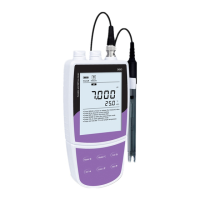Where:
K = Cell constant
C
std
= Value of conductivity standard solution
C
meas
= Measured value
G = Raw cell constant (0.1, 1 or 10)
Calculating the Temperature Coefficient
1. Do not connect the temperature probe to the meter.
2. Press and hold the °C key to enter the temperature setting.
3. Press the / key to set the temperature to 25° C and press
the Enter key to confirm.
4. Place the conductivity electrode into the sample solution, record
the temperature value T
A
and conductivity value C
TA
.
5. Condition the sample solution and electrode to a temperature T
B
that is about 5 to 10° C different from T
A
. Record the conductivity
value C
TB
.
6. Calculate the temperature coefficient using the formula below.
T
C
= [C
TB
– C
TA
] / [C
TA
(T
B
– 25) – C
TB
(T
A
– 25)]
Where:
T
C
= Temperature coefficient
C
TA
= Conductivity at temperature A
C
TB
= Conductivity at temperature B
T
A
= Temperature A
T
B
= Temperature B
Calculating the TDS Conversion Factor
To determine the TDS factor of sample solution use the formula below.
Factor = Actual TDS / Actual Conductivity @25° C
Where:
Actual TDS = value from the high purity water and precisely weighed
NaCl or KCL reagent
Actual Conductivity = the meter measured conductivity value
For example:
Dissolve 64 grams of the potassium chloride (KCl) reagent in 1 liter
distilled water. If measured conductivity is 100 mS/cm, then TDS factor
is 0.64.
Conductivity to TDS Conversion Factors

